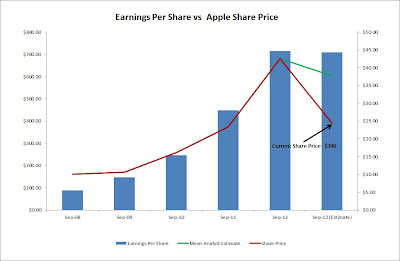It has been
a turbulent time for Apple investors as the share price fell from highs of $705
last year to close at $390 on Friday.
With their Q2 results to be released on Tuesday, it may be a brave call
to jump in before, however for the contrarian investor is this the perfect
opportunity?
Why has the share price fallen?
The stock
has fallen 45% since its high in less than twelve months on fears that their
flagship products; the iPhone and iPad are losing market share demand of the
ever more competitive market.
A number of
companies who supply Apple parts have announced slowing sales which have
spooked investors. Cirrus Logic (CRUS)
which supplies analogue and audio chips for the iPhone and iPad announced good
earnings, however ended the year with over $20m in inventory reserves which
suggests slowing demand for Apple’s products.
The last
five years have seen Apple in its mass growth phase, and it is difficult to
quantify earnings potential and product demand until market saturation has been
met. The latest announcement from
Cirrus Logic highlights just this, whilst they had a great year, they may have
overestimated continued demand for Apple products.
The IDC recently
released data for their Quarterly PC Tracker and revealed preliminary estimates
had Apple ship 1.4m units, a 7.5% decline since 2012. They noted that this decline may have been
due to a steep rise in competition for the iPad. With more competitors producing cheaper
products, market share has been eroded.
Will Earnings Suffer?
Whilst
Apple has been relatively reserved about pipeline products their current ones
do a great job in hooking people for their next models. In 2011, UBS carried out some research into
retention rates for the iPhone; this was a whopping 89% with its nearest competitor
at 39%. Whilst we are a couple of years
down the line, previous earnings have supported the results. The 2013 Q1 results showed a record haul for
iPhone sales of 47.8m units compared to 37m a year before, iPads also followed
suit selling 22.9m compared to 15.4m the year earlier.
Although
Apple looks to have more competition against Samsung and Microsoft the
projected earnings for this year don’t look to suffer that much as a result.
First
quarter in 2013 saw record revenue at $54bn, however gross margin had decreased
somewhat from the year before.
The fall in
the share price has been attributable to very little hard facts and mostly on
speculation. Whilst many have been worried over the reducing gross margin, this
may have be down to cyclical factors used in product development. With the earnings looking to remain solid for
2013, contrarian investors will be licking their lips as the stock remains out
of favour falling below $400 a share.
Earnings
per share looks to remain flat for 2013 which will not come as a surprise to
many because the gross margin looks to decrease somewhat from 2012. Capital equipment expenditure ahead of the
iPhone 5 release may have been the cause for this gross margin decrease and has
the potential to rise again once the iPhone 5S is released as modifications to
hardware are likely to be minimal.
Using Apple’s
lower end estimates they are looking to grow revenue and net profit for
2013. The current share price, just
based on earnings is very low and factoring in the vast amount of cash on their
balance sheet, $150bn, the company looks even more attractive. Looking at Google Inc (GOOG) a company with
similar merit, they have a P/E of 24.3 compared to Apple’s 8.7 (without $150bn
cash)!
What is next for Apple?
Pipeline
products are fundamental in this fast paced technology sector, and the company
has been relatively quiet about what is to come. They have hinted at a cheaper iPhone which
should help snatch up some of the market share against the cheaper competitors
and a new iPad release. It is likely
there are more products on the development line which are sure to draw in a
huge amount of revenue, however it is hard to pin point release dates.
China
Mobile is one of the world’s largest mobile networks without direct access to
the iPhone and this may be about to change as they look to invest $30bn in the
new 4G network that will support it.
Much time has been spent in generating a relationship with the company
and this summer may see Apple gain further exposure to the Chinese market.
One thing
is certain, the ever growing cash level that dwarfs Apple’s competitors
provides potential for some significant developments. There are a number of uses for this cash that
will be beneficial to the share price such as research and development,
M&A, share buy backs or increased dividends.
The share
price has fallen back to levels seen towards the end of 2011 and it is unlikely
earnings are going to do the same. The
market is pricing in a dramatic fall in earnings for 2013 and subsequent years
(almost 50%) and do not take into account new product releases.
Out of 55
broker recommendations, 80% rate this stock as a buy with a mean price estimate
of $602.
Apple is a
prime example of what contrarian investor’s look for; stocks that are out of favour with earnings and balance sheet strength. I agree with the brokers and at $390 Apple
shares are a steal.




